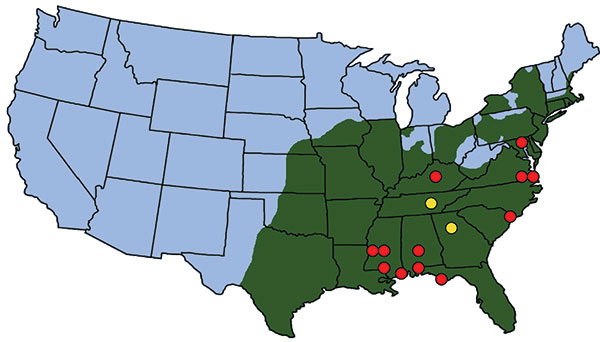Volume 15, Number 9—September 2009
Dispatch
Rickettsia parkeri in Amblyomma americanum Ticks, Tennessee and Georgia, USA
Figure

Figure. Location of ticks, Rickettsia parkeri in ticks, and human cases of rickettsiosis in the United States. Green shading indicates approximate distribution of Amblyomma americanum ticks, which completely overlaps with the known or suspected distribution of A. maculatum. Yellow circles indicate locations where R. parkeri was detected in A. americanum ticks (this study). Red circles indicate locations of confirmed or suspected cases of R. parkeri infection in humans (11).
References
- Parker RR, Hohls GM, Cox GW, David GE. Observations on an infectious agent from Amblyomma maculatum. Public Health Rep. 1939;54:1482–4.
- Paddock CD, Sumner JW, Comer JA, Zaki SR, Goldsmith CS, Goddard J, Rickettsia parkeri: a newly recognized cause of spotted fever rickettsiosis in the United States. Clin Infect Dis. 2004;38:805–11. DOIPubMedGoogle Scholar
- Ralph D, Pretzman C, Daugherty N, Poetter K. Genetic relationships among the members of the family Rickettsiaceae as shown by DNA restriction fragment polymorphism analysis. Ann N Y Acad Sci. 1990;590:541–52. DOIPubMedGoogle Scholar
- Sumner JW, Durden LA, Goddard J, Stromdahl EY, Clark KL, Reeves WK, Gulf Coast ticks (Amblyomma maculatum) and Rickettsia parkeri, United States. Emerg Infect Dis. 2007;13:751–3.PubMedGoogle Scholar
- Goddard J. Experimental infection of lone star ticks, Amblyomma americanum (L.), with Rickettsia parkeri and exposure of guinea pigs to the agent. J Med Entomol. 2003;40:686–9.PubMedGoogle Scholar
- Merten HA, Durden LA. A state-by-state survey of ticks recorded from humans in the United States. J Vector Ecol. 2000;25:102–13.PubMedGoogle Scholar
- Labruna MB, Whitworth T, Bouyer DH, McBride JW, Camargo LMA, Camargo EP, Rickettsia bellii and Rickettsia amblyommii in Amblyomma ticks from the State of Rondonia, Western Amazon, Brazil. J Med Entomol. 2004;41:1073–81.PubMedGoogle Scholar
- Eremeeva M, Yu X, Raoult D. Differentiation among spotted fever group rickettsiae species by analysis of restriction fragment length polymorphism of PCR-amplified DNA. J Clin Microbiol. 1994;32:803–10.PubMedGoogle Scholar
- Durden LA, Kollars TM Jr. An annotated list of the ticks (Acari: Ixodoidea) of Tennessee, with records of four exotic species for the United States. Bulletin of the Society of Vector Ecology. 1992;17:125–31.
- Childs JE, Paddock CD. The ascendancy of Amblyomma americanum as a vector of pathogens affecting humans in the United States. Annu Rev Entomol. 2003;48:307–37. DOIPubMedGoogle Scholar
- Paddock CD, Finley RW, Wright CS, Robinson HN, Schrodt BJ, Lane CC, Rickettsia parkeri rickettsiosis and its clinical distinction from Rocky Mountain spotted fever. Clin Infect Dis. 2008;47:1188–96. DOIPubMedGoogle Scholar
- Apperson CS, Engber B, Nicholson WL, Mead DG, Engel J, Yabsley MJ, Tick-borne diseases in North Carolina: is “Rickettsia amblyommii” a possible cause of rickettsiosis reported as Rocky Mountain spotted fever? Vector Borne Zoonotic Dis. 2008;8:597–606. DOIPubMedGoogle Scholar
- Raoult D, Paddock CD. Rickettsia parkeri infection and other spotted fevers in the United States. N Engl J Med. 2005;353:626–7. DOIPubMedGoogle Scholar
- Parola P, Paddock CD, Raoult D. Tick-borne rickettsioses around the world: emerging diseases challenging old concepts. Clin Microbiol Rev. 2005;18:719–56. DOIPubMedGoogle Scholar
- Whitman TJ, Richards AL, Paddock CD, Tamminga CL, Sniezek PJ, Jiang J, Rickettsia parkeri infection after tick bite, Virginia. Emerg Infect Dis. 2007;13:334–6. DOIPubMedGoogle Scholar
Page created: December 07, 2010
Page updated: December 07, 2010
Page reviewed: December 07, 2010
The conclusions, findings, and opinions expressed by authors contributing to this journal do not necessarily reflect the official position of the U.S. Department of Health and Human Services, the Public Health Service, the Centers for Disease Control and Prevention, or the authors' affiliated institutions. Use of trade names is for identification only and does not imply endorsement by any of the groups named above.